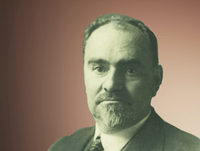Believing in the cognitive power of science, Federigo Enriques placed no limits on his interests, considering human understanding as being limited by the sheer infinity of objects to be studied. In his mindset, philosophy, mathematics and geometry blended and mutually enriched one another, bringing the humanistic and the scientific disciplines together rather than setting them in opposition, in line with the then hegemonic current of Croce and Gentile's neo-idealism.
 Federigo Enriques was born in Livorno in 1871 to a Jewish family.
Federigo Enriques was born in Livorno in 1871 to a Jewish family.
He studied Mathematics at the Scuola Normale Superiore in Pisa and graduated in 1891.
He then moved to Rome to take Luigi Cremona’s Geometry course and there he met someone who, besides a great collaborator, would become a close friend and even a brother-in-law: the mathematician Guido Castelnuovo (he married Federigo's sister Elbina in 1896).
By now it was clear that his predominant interest was in geometry and so, in 1893, Enriques delved deeper into the subject by attending Corrado Segre’s lectures in Turin and began writing on the subject himself.
Having made a name for himself in the academic world, he was called to Bologna in 1894 to teach projective and descriptive geometry, obtaining the professorship two years later.
His period in Bologna, which lasted until 1922, was the most productive in terms of both his scientific work and his approach to the philosophical world. Enriques considered the two branches of knowledge inseparable, united by having intuition as the central focus of their approach. This idea, however, did not align him with the intuitionist faction, which was opposed to the formalist one, and spared him the heated clash that had been going on between the two currents of thought since the end of the 19th century.
In 1906 he founded the Società filosofica italiana, of which he was president from 1907 to 1913, and managed to organise and bring the 4th International Congress of Philosophy to Bologna. In the packed Sala dello Stabat Mater of the Archiginnasio, the 1911 Bolognese congress had introduced a great novelty: it had attracted scientists as well as philosophers, thus irritating Benedetto Croce who, in no uncertain terms, called Enriques an amateur philosopher.
Croce wasn’t wrong when he spoke of the professor's self-taught philosophical approach, and yet, probably precisely because of this, the mathematician from Livorno enriched the philosophical-scientific debate of the time, bringing a new vision of thought that was less aligned with the currents of the period (positivism and idealism, absolutism and relativism) and opposed to any form of dualism, being, instead, open to moderate, balanced truths.
These same principles can also be seen in his mathematical approach, which overcame the division between geometry and analysis – a division that had made the latter triumph in the 19th century – and found a common solution in their being approached with the same geometric spirit, through which Enriques himself achieved brilliant results. Here, too, intuition led the mathematician to quite unique practical and working methods: the most interesting and unusual elements of his work often arose from the walks he took with Castelnuovo, and not from sitting at his desk.
Enriques’ interest in popularisation soon led him, in 1907, to found Rivista di scienza, a magazine later renamed Scientia, published in Italy by Zanichelli, but also published in Germany and France until 1988.
Success and international recognition were thus well established, and in 1922 Enriques was called to Rome to hold the professorship of Advanced Mathematics and later that of Advanced Geometry. From the year he moved until 1934, he served as president of the Italian Society of Physical and Mathematical Sciences Mathesis and editor of Periodico di matematiche, a specialist journal aimed at secondary school teachers.
In Rome, despite the fact that Giovanni Gentile, like Croce, had been very critical of Enriques ever since his review of Problemi della scienza (Problems of Science) published by the professor in 1906, the two thinkers did to some extend resolve their differences: Enriques proved open to Gentile's reform, while Gentile rethought his stance on the cognitive value of science and, above all, on the role that the history of science – another great passion of Enriques – could play within his scholarly conception. This partial reconciliation led, in 1925, to Enriques being assigned the directorship of the mathematical section of the Enciclopedia Italiana, for which he personally wrote 36 entries.
He held this prestigious post until 1938, when, due to his Jewish origins, Enriques was removed from all public duties, including teaching.
The traumas of war and the injustice of the racial laws did not, however, prevent him from continuing with his research and publications, which he issued in Italy and abroad under the pseudonym of Adriano Giovannini.
The regime finally fell, and in 1944 he resumed his professorship, but by then the philosopher-scientist was exhausted by age and a severe heart condition. He died just two years later.
